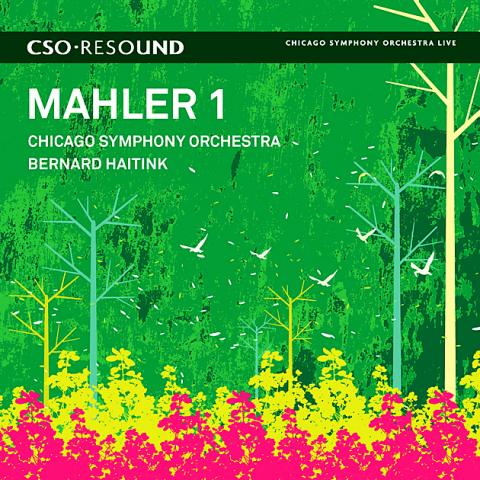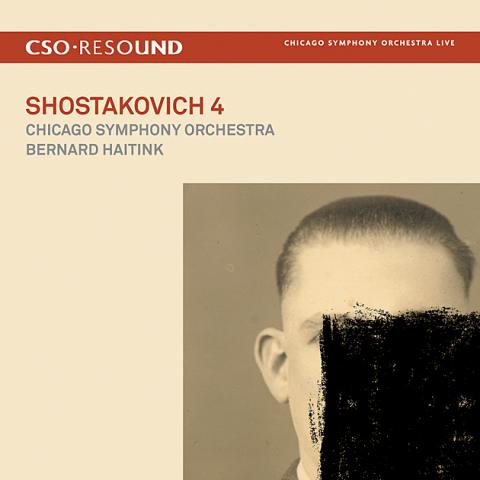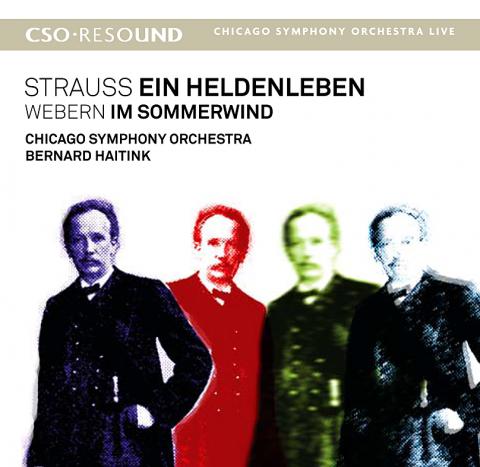What characterizes Amsterdam-born Bernard Haitink as a conductor? I think it’s a quiet, serious, un-melodramatic commitment. There’s none of the swept-back hair and sense of a god on the podium cultivated by Karajan, none of the tantrums of Toscanini, and none of the personality cult that it could be argued Leonard Bernstein fostered. Haitink rarely gives the impression of being intoxicated by the works in hand — rather, he seeks to tame them, and at the same time to make sure their essential qualities, both in loud passages and in contemplative ones, are given appropriate credit. In all this he’s very Dutch — unassuming, yet immensely reliable. But is this enough?
During his time with the Chicago Symphony Orchestra (CSO), Haitink built up a small library of orchestral recordings in which Mahler features prominently. This month, therefore, we’ll consider two symphonies, the 1st and the 6th, and see how they compare with Haitink’s versions of equally famous works by Richard Strauss and Shostakovich.
With Mahler’s Symphony No. 1 the issue is whether tenderness and lyricism are at its heart, or whether it merits dynamism of a kind. Only if you believe the former are you likely to take to Haitink’s treatment. This is at best a very well-mannered reading. Needless to say the recording quality is top of its range.

But with Mahler’s Symphony No. 6 the combination of Haitink, Mahler and the CSO works gloriously. Spread over two CDs, this is an absolutely stunning rendering of this under-rated work. Somehow the orchestra’s fullness of sound combines with Mahler’s transcendental aspirations, and Haitink’s sometimes self-effacing manner in no way stands in their way. In fact he’s to be congratulated on bringing about such a fabulous marriage.
Strauss’s Ein Heldenleben, by contrast, is a brightly-recorded disc that left me strangely unmoved. There are many fine recordings of this wonderful tone-poem, and what this one has to offer is an unusual coupling — Webern’s early Im Sommerwind, written when he was 19 and under the influence of Strauss, rather than the enfant-terrible of modernism he was to become.
Lastly, Shostakovich’s Symphony No. 4. This is the symphony Shostakovich was writing when Stalin’s article condemning his opera Lady Macbeth of Mtensk was published in Pravda — effectively a warning to move away from modernist experiment and return to popular styles. Shostakovich, though badly shaken (he thought he might be sent to Siberia, or shot), carried on with the symphony, and it was, rather surprisingly, accepted for performance. But during the rehearsals various officials showed up, and the outcome was that he was told there would be no premiere. He consequently put the symphony in a drawer and it wasn’t played for another 25 years.

The problem with this symphony isn’t that it’s modernistic but that it’s terminally introspective. It opens briskly enough, but soon you’re mired in depression — whether political or personal is anyone’s guess. This never lets up, depositing you instead at the end in the very bottom of the pit. Haitink’s sensitivity can do little to redeem it.
Along with the CD comes a Bonus DVD. This contains extracts from the symphony in performance, interrupted by two actors narrating the background to its aborted premiere and reading quotations from letters and poems of the time. I found this all rather tiresome, and was glad when it was over. Nevertheless, if you don’t know the background to the Fourth Symphony this would be a painless way to acquire it.
The most interesting item of the DVD is an interview with Haitink. In it he remembers how he met Shostakovich in Russia. It was after a concert featuring Bruckner’s Symphony No. 9, and Haitink had the impression it had been the first time Shostakovich had heard the work. He was frail, Haitink says, and besides that not a man to express himself openly. He suffered from depression all his life, and rarely smiled. But he remembers that in his study were plaster effigies of Beethoven and Mahler. These were his masters, Haitink considers — composers who wrote from the heart. And this is what Shostakovich mostly does, he adds, and it’s consequently a pity he’s sometimes been associated in the West with factory routines and military triumphalism.

Haitink recalls that he wasn’t at first a fan of the Soviet composer. In Amsterdam in his early years his music was almost unknown, and when played usually despised. Mahler was the fashion, but when Haitink eventually conducted a performance of Shostakovich’s Symphony No. 14 it was a considerable success, and he was invited by the record company Decca to record the entire Shostakovich symphonic cycle.
On the Symphony No. 4 Haitink expresses his belief that it’s a work in which a young man first discovers within himself his full potential. The 1st shows promise, but the 2nd and 3rd are too full of Soviet ideology for Haitink’s taste. The fourth, by contrast, impressed him enormously when he first encountered it, and he considers even the 5th as a reluctant return to a more popular manner. He ends by quoting Shostakovich as saying, when the symphony was eventually performed in 1961, that maybe it was better than some of the ones that succeeded it. This, as I’ve already made clear, is an opinion that it isn’t hard to disagree with.


May 26 to June 1 When the Qing Dynasty first took control over many parts of Taiwan in 1684, it roughly continued the Kingdom of Tungning’s administrative borders (see below), setting up one prefecture and three counties. The actual area of control covered today’s Chiayi, Tainan and Kaohsiung. The administrative center was in Taiwan Prefecture, in today’s Tainan. But as Han settlement expanded and due to rebellions and other international incidents, the administrative units became more complex. By the time Taiwan became a province of the Qing in 1887, there were three prefectures, eleven counties, three subprefectures and one directly-administered prefecture, with

It’s an enormous dome of colorful glass, something between the Sistine Chapel and a Marc Chagall fresco. And yet, it’s just a subway station. Formosa Boulevard is the heart of Kaohsiung’s mass transit system. In metro terms, it’s modest: the only transfer station in a network with just two lines. But it’s a landmark nonetheless: a civic space that serves as much more than a point of transit. On a hot Sunday, the corridors and vast halls are filled with a market selling everything from second-hand clothes to toys and house decorations. It’s just one of the many events the station hosts,

Among Thailand’s Chinese Nationalist Party (KMT) villages, a certain rivalry exists between Arunothai, the largest of these villages, and Mae Salong, which is currently the most prosperous. Historically, the rivalry stems from a split in KMT military factions in the early 1960s, which divided command and opium territories after Chiang Kai-shek (蔣介石) cut off open support in 1961 due to international pressure (see part two, “The KMT opium lords of the Golden Triangle,” on May 20). But today this rivalry manifests as a different kind of split, with Arunothai leading a pro-China faction and Mae Salong staunchly aligned to Taiwan.

Two moves show Taichung Mayor Lu Shiow-yen (盧秀燕) is gunning for Chinese Nationalist Party (KMT) party chair and the 2028 presidential election. Technically, these are not yet “officially” official, but by the rules of Taiwan politics, she is now on the dance floor. Earlier this month Lu confirmed in an interview in Japan’s Nikkei that she was considering running for KMT chair. This is not new news, but according to reports from her camp she previously was still considering the case for and against running. By choosing a respected, international news outlet, she declared it to the world. While the outside world